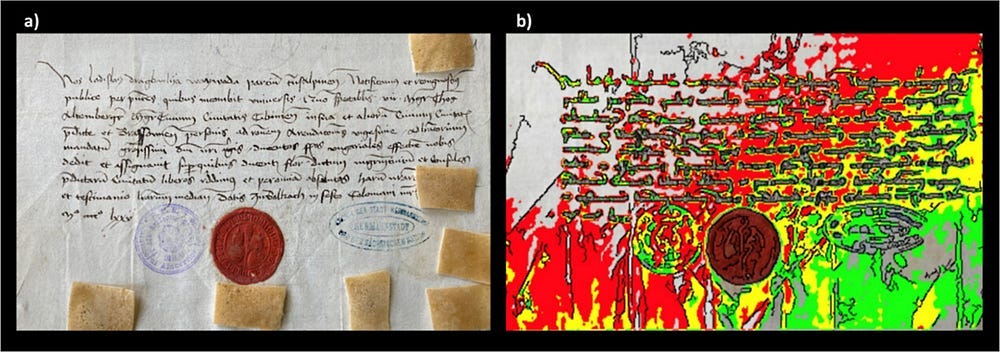What Happens When You Analyze Vlad The Impaler’s Letters With Advanced Tech
Studying the proteins of a figure that possibly gave rise to Dracula

“I could hear a lot of words often repeated…so I quietly got my polyglot dictionary from my bag and looked them out. I must say they were not cheering to me, for amongst them were “Ordog” — Satan, “pokol” — hell, “stregoica” — witch, “vrolok” and “vlkoslak” — both of which mean the same thing…something that is either were-wolf or vampire. (Mem., I must ask the Count about these superstitions).”
— Dracula, Bram Stoker 1897
For the past hundred years or so, we’ve been treated to — or tormented by — a fantastic literary character that’s taken on a life of its own. While many may not know the name Bram Stoker, most know his creation Dracula — even more vampires.
But like so many things in history, a mixture of time, culture, and folklore makes it hard to know where something actually begins. For the Dracula story, many point back to Vlad III Drăculea, born in Transylvania, and eventual military governor of Walachia (within present day Romania), as the real-life inspiration for the character.
The name Dracula simply means “son of Dracul.” That family moniker derived from the Latin “draco,” or dragon, as in “Order of the Dragon.” It was a group established by the Holy Roman Emperor in a time of crisis to defend the region against Ottoman invaders in the fifteenth century.
It’s speculated Stoker came across references to Vlad’s brutality and worked his name into a story involving folklore from the region. Regardless of whether this is true, Vlad “The Impaler” existed. Moreover, he left three letters, in beautiful condition.
Recently a group of scientists analyzed them with advanced technology, finding half of a millennia's worth of proteins and peptides. They painted a picture. Both of Vlad’s time, and possibly a snapshot of a unique health problem which might tie him even closer to blood loss.
And it’s all thanks to high-resolution mass spectrometry (MS).
The Technology And The Letters

To put it simply, MS is an analytical technique that tells you the components or structure of what something is made of. In this case, proteins and peptides were sought out. And they serve a dual purpose.
They can possibly tell us something about the person who wrote the letter.
The technique is sensitive enough to detect ages of the proteins and peptides, so modern contaminants can be excluded.
However, older versions of MS required sections of samples to be destroyed so testing could be done, which is obviously bad for historical analysis. But the tech has gotten better.
The team conducting the study in their article Count Dracula Resurrected: Proteomic Analysis of Vlad III the Impaler’s Documents by EVA Technology and Mass Spectrometry explain the technique is now completely non-invasive.
Analysis involves putting a plastic film of ethylene-vinyl acetate (EVA) with cation and anion exchangers onto the sample. It “harvests” proteins and small molecules, without damaging the surface. In other words, they just lay a specialized plastic or paper over the item examined.
Of the three letters, two were written by Vlad in 1475, and one in 1457. All are in excellent condition. The earlier was professionally restored, but the newer letters were kept in the archives of the city of Sibiu and rarely handled.
The team also examined the documents with a UV light apparatus, which indicated areas of high protein concentration before the EVA material was ever placed on the letters. They also studied a modern letter. Proteins and peptides found within were used as examples of contaminants on Vlad’s documents.
So, in an oddly ironic way, scientists sucked proteins and peptides out of letters written by a man proclaimed to be the inspiration for a world-famous bloodsucker. The analysis gave incredible detail.
What They Found
Through a deamidation process — break down of amino acids — the researchers could detect older versus newer proteins and peptides. They used this to exclude contaminants, along with any similar examples found with the modern comparison letter.
Obviously, they found many proteins related to skin. However, they also discovered proteins and peptides associated “with some ciliopathies of the respiratory tract and with retinal diseases.” Proteins associated with blood, sweat, inflammation, and tears were also found. Peptides linked to the retina and tears were on the two letters from 1475 too.
The researchers added this combo together to posit Vlad may have suffered from hemolacria, a condition where the afflicted shed tears of blood. They also note this is mentioned in some folklore.

But not only human material was found, many peptides related to bacteria were also present. In particular, things associated with “intestinal, urinary tract infections, and health-care-associated infections.”
Moreover, peptides related to “Y. pestis,” the pathological bacteria that caused the black plague were found as well. And to add to the cocktail, bacteria associated with overripened fruit and fruit flies also resided on the letters.
The researchers note that in the fifteenth century Walachia was a “meeting point” for militaries, merchants, and populations from West and East. It likely functioned as a mixing bowl for pathogens too.
So, what do we make out of this research project? Well, it’s nuanced.
A Sign Of Things To Come
While interesting, all of this is of course conjecture. The researchers even admit many people could have touched those letters over the years and added to the biological snail trail hidden on them. Although logic does dictate the oldest proteins and peptides came from Mr. Impaler.
In the end, it’s all just an educated guess about Vlad’s health conditions. But proteins and peptides do appear to point to various health issues — at least inflammation and respiratory problems. The letters also give a unique snapshot of the “environmental conditions” of Walachia in Vlad’s time.
It’s also fascinating that the technology of our day can examine something touched by a widely known historical figure from five hundred years ago to this detail. In fact, the researchers say this is the first time to their knowledge something like this has been done. And it’ll only get better.
For instance, a recent research project analyzed artwork on tomb walls within the Valley of the Kings in Egypt with special X-ray technology. Like MS and EVA, it allowed the researchers to analyze the paint on the walls in a totally non-invasive way.
They discovered — at least in two cases — the painting process was much different than expected. Even mistakes covered over by workers became visible.
One can imagine as technology becomes more powerful, cheaper, and non-invasive; it’ll create new fields within the study of history. And to think, it all started with Dracula.
-Originally posted on Medium 8/27/23


